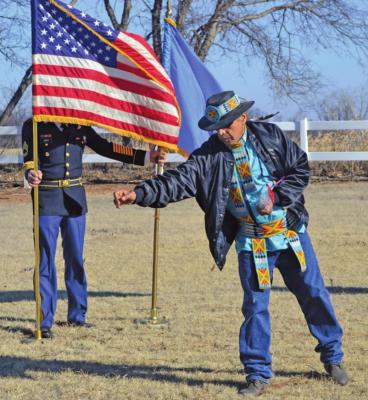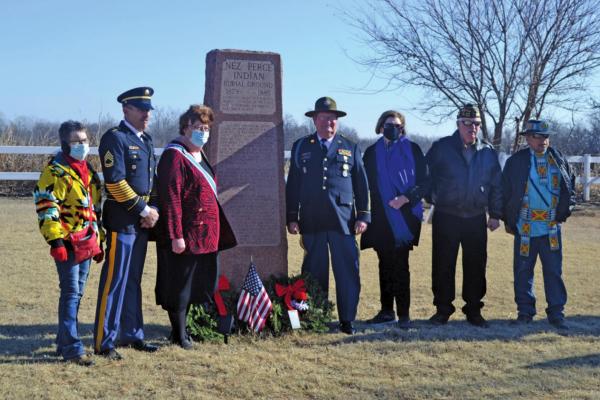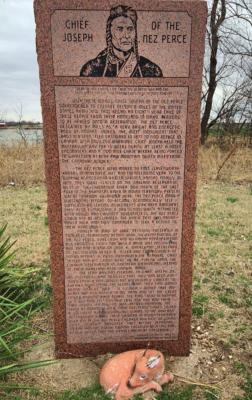Nez Perce Tribe recognized in Wreaths Across America event
The Nez Perce Trail Foundation along with other organizations such as the Daughters of the American Revolution, the American Legion, the VFW Post from Ponca City and the Tonkawa Tribe, came together in Tonkawa, Oklahoma to participate in the Wreaths Across America ceremony on Dec. 19, 2020.
The annual event is held to celebrate and memorialize those who served in the United States armed forces and those who have served with distinction. Citizens and the Lewis and Clark participants joined together to remember national and military heroes who opened the vast majority of the west to exploration.
The 2020 Wreaths Across America event included the recognition of the Nez Perce Tribe, thanks in part to Jim Mallory, Vice Chairman of the Lewis and Clark Trust. The focus being the Nez Perce son of William Clark: Daytime Smoke (Halahtookit), born in 1806, months after the Corps of Discovery departed the Nez Perce village and headed home.
Daytime Smoke was 71 years old during the Nez Perce War of 1877. The Nez Perce sought freedom and were captured by the US Army 40 miles from the Canadian border. Daytime Smoke was taken prisoner along with the rest of the Nez Perce who were incarcerated in the Oklahoma Territory.
Daytime Smoke passed away near what is now the current community of Tonkawa, Oklahoma.
Though Daytime Smoke is not considered a US veteran, Mallory stated that he and the other Nez Perce deserve respect as human beings. The Nez Perce were instrumental in the success of the Lewis and Clark party, taking in the tired and hungry group and furnishing them with fresh horses and food to eat. They also took care of the party’s tired horses for their return trip and fed them again.
The exact resting place of Daytime Smoke and the many Nez Perce men, women and children who passed away in Tonkawa is unknown.
The Nez Perce Tonkawa memorial was set up in July of 1992 by Henry Allen Sr., Chief of the Tonkawa Tribe to remember and honor the Nez Perce people.
Wreaths laid at the memorial were provided by the National Society of the Daughters of the American Revolution, Ponca City Chapter. VFW 1202 Post Commander Gary Miles of Ponca City was instrumental in the organization of the wreath laying ceremony. Dignitaries in attendance were the NSDAR Vice President General-Honorary Oklahoma State Regent Sue Allen, former Tonkawa Chief Don Patterson, Cecelia Schieber Ponca City Chapter Regent, VFW Post Senior Vice Dan Hoac and Chaplin Melvin Osburn.
The Chief Joseph Memorial on Highway 60, it is inscribed withe the history of the Nez Perce in the area and reads as follows: “Hear me, my chiefs, I am tired, my heart’s sick and sad from where the sun now stands. I will fight no more, forever.” With these words, Chief Joseph of the Nez Perce, surrendered to Colonel Nelson A. Miles, of the United States Army, and thus began an eight-year exile of these people from their homeland in Idaho. Refusing to be herded into a reservation, the Nez Perce, described by Miles as “a very bright and energetic body of Indians, indeed. The most intelligent that I have ever seen” - they fled eastward in 1877 to find refuge in Canada. With only 250 warriors, Chief Joseph held the military at bay for fifteen weeks during at least a dozen encounters and a 1700 mile chase before being forced to surrender at Bear Paw Mountain, 30 miles from the Canadian border.
The Nez Perce were moved to Fort Leavenworth, Kansas in November 1877 and the following year to the Quapaw agency near Baxter Springs, Kansas. Finally, in 1879 they were placed on the Oakland Reservation, west of the Chickasha River and north of the Salt Fork of the Arkansas River in Indian Territory, the present site of Tonkawa, Oklahoma. Here, the Nez Perce made a substantial effort to become economically self-sufficient by leasing agreements with area ranchers. They also established a ‘day school’ which attracted both adults and children. Nevertheless the Nez Perce could not be acclimated. The death rate was abnormally high and they continued to seek a return to their homeland.
Finally, in May of 1884 petitions presented in Congress demanded action upon the repatriation of the Nez Perce bore fruit and an Indian appropriation bill provided funds for such a move, was passed. The bill became a law on July 4th, whereupon Secretary of the Interior, Henry M. Tiller and Commissioner of Indian Affairs, H. Price, authorized the removal of Chief Joseph and his group were to be placed upon the Colville Reservation in northern Washington, instead of their homeland near Lapwai, Idaho.
The plan was not pleasing to Chief Joseph or his followers who objected that they have been punished enough and would not voluntarily consent to further humiliation. The segregation, they said, would brand them as “wild”. “If I could, I would take my heart out and hold it in my hand and let the great father, and the white people see, that there is nothing in it but kind feelings and love for him and them,” said Joseph on May 22, 1885. Before boarding the train at Arkansas City, four Nez Perce Chiefs signed a document relinquishing all claims to the Oakland Reservation. During their sojourn in Indian Territory over one hundred of the Nez Perce children had died, including Chief Joseph’s daughter, thus before departing, Joseph had the burial ground enclosed by a log barrier in order that the graves might be preserved.






